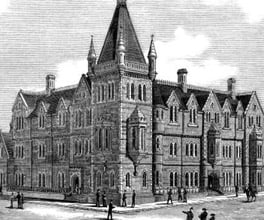Working Men's College
One of the main principles of the 8-hour movement was that if working-class men were given leisure time, they would have the opportunity to educate themselves.
There were some who believed that the working class could not be educated. But despite such opposition, in 1881 the Honorable Francis Ormond, a noted Victorian philanthropist and member of parliament, suggested that a technical institute be built in Melbourne, offering further education for working men and women. He offered to match the sum raised through public subscription if the government could provide a site for the College.
William Murphy, a self-educated cabinet maker and the elected secretary of Trades Hall, decided to raise the public money.
While Trades Hall itself was an institute aimed at bettering working-class education standards, Murphy saw a real need for a formal educational institution designed specifically for workers. He felt that Ormond's offer was their best chance.
Ormond had expected that funds would be raised through Melbourne's wealthy upper classes. But it was unions and workers themselves that provided the money to fund the college, with the union movement raising £5 for every £1 contributed by employers.
Six years later, in June 1887, the Working Men's College opened. Ormond had hoped that 400 students would enrol in the first two years, but 600 students enrolled in the first two months, with numbers reaching 2000 in the first two years.
Enrolling numbers continued to climb and over time, the College expanded its curriculum to include subjects from a variety of practical and vocational fields, from business, to engineering, to fine arts.
It must be obvious to any impartial mind, that had it not been for the extra leisure which the 8 Hours' System affords, the educational advantages which now exist, and must increase for the youth of these young colonies by the operation of technical training, would have remained a sealed book for an indefinite period.
– William Murphy, Trades Hall Secretary 1900
Murphy, W E 1896–1900, History of the eight hours' movement, Spectator, Melbourne, Vic.
The College is still in operation today, but under a different name – the Royal Melbourne Institute of Technology (RMIT). A statue of Francis Ormond commemorates his contribution to its foundation.











